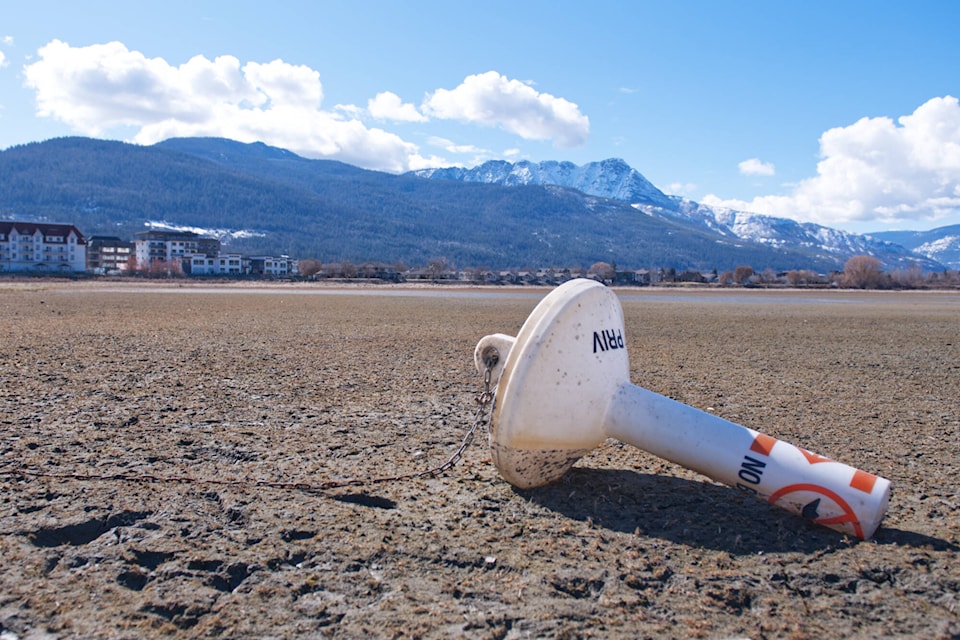Gareth Seys has been closely monitoring the water level of Shuswap Lake.
As of April 1, data maintained by the City of Salmon Arm showed the lake was at its lowest level for that date, 344.772 metres, since 1996.
On April 5, Seys, the manager of Shuswap Marina in Blind Bay, shared the first in a series of water level video log on social media.
“The record keepers are calling this a 200-year low, so none of us have seen it this low, ever. When I look at the measurements versus last year at the same time, we are about a metre lower…,” Seys explains in the video.
In an April 4 interview, Seys told the Observer the lake level was a concern. Though he’d been able to launch some boats, he said “if we don’t get any precipitation through the spring and it stays cool like this, it doesn’t bode very well for a great runoff.”
At the time of Seys’ most recent video, shared on April 18, the area had received some precipitation and the water level had risen.
“We’ve had some rain and it looks like there’s more coming, which is great! Also, a fresh snowline up there,” said Seys. “Still not very warm out but anyways, we’re getting water in the lake. It’s come up maybe two-and-a-half, three inches so far from where it kind of bottomed out on us.”
As of April 15, city data had the lake at 344.883 metres.
The same morning Seys shared his latest video on Shuswap Marina’s Facebook page, Columbia Shuswap Regional District (CSRD) directors and staff took part in a Shuswap Emergency Program Executive meeting. The second topic on the agenda was an update from protective services team leader Derek Sutherland on freshet, flood risk and wildfire conditions.
Sutherland began his presentation by commenting on the lake’s level, noting it’s “incredibly low, which means it has a lot of capacity for flood.”
“However, we’re quite concerned about the groundwater situation and drought issues that contribute to wildfire risk,” Sutherland continued. “Our snowpack is currently… sitting at average in our area, and other areas in the province are above average, which could affect us. So we’re really not sure at this point what to expect as far as a flood is concerned, but all indications are pointing to a fairly average year. But we are concerned about dry and drought.”
CSRD Emergency Program Facilitator Cathy Semchuk noted the B.C. government’s drought information portal had a large portion of the regional district, including Salmon Arm, in Level 3, at which “conditions are becoming severely dry.” But she and Sutherland said that could change with June rains.
“BC Wildfire always stresses to us that the fire season will be affected by the rains of June,” said Sutherland. “So we’re always looking for a fairly decent amount of rain in June but not decent enough that it creates landslides and floods. We’re running that razor’s edge all the time.”
Sutherland said CSRD staff would be meeting with BC Wildfire and Emergency Management BC staff on April 19 to get an update on flood and fire situations and what the outlook is for the spring. However, Electoral Area D director Dean Trumbley advised caution regarding drought concerns as there’s been zero freshet release. At the same time, the area continues to receive snowfall, even at lower elevations. Trumbley said he was in the mountains the other day and was turned around by two feet of snow accumulated just above 1,100 metre mark, “which I’ve never seen in about four or five years.”
Read more: Low lake level prompts public warnings for Shuswap boat launches
Read more: Shuswap Lake levels surpass 1997 flooding mark
“I think we’re getting a little bit of a false read when it comes to the melt right now and that’s why… the lakes and the rivers are so low,” said Trumbley. “My biggest concern is if you get a spell of hot weather, because that snow is so low and with the upper snow packs being average to above average, we could be looking at flood conditions this year which could be catastrophic, especially if you combine that with rains in June.
“As far as wildfire, all of that stuff is actually not too bad. It’s a good indicator – as long we can push that weather into July, the better we are for the fire season.”
Sutherland agreed a longer period of cooler weather would be beneficial. The meeting’s chair, Salmon Arm Mayor Alan Harrison, suggested the city’s residents also agree.
“I think the good thing is is our residents, they’re having conversations just like this all over Salmon Arm,” said Harrison. “We’re willing to trade off a wet June for a smokeless summer.”
lachlan@saobserver.net
Like us on Facebook and follow us on Twitter
Sign up for our newsletter to get Salmon Arm stories in your inbox every morning.
